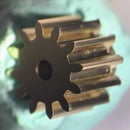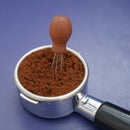Introduction: A Tiny Thumb Plane
Thumb (or finger) planes were originally designed for shaping the top and back plates on violins. The sole is typically convex, which lends itself well to producing the concavities observed in instrument making. Personally, I think the uses of a thumb plane are far more diverse; they are incredibly useful in almost all forms of woodworking: carving, trimming, chamfering, shaping handles, making doweling, shaping ukulele/guitar necks etc...
I must stress that this plane is tiny - almost certainly the smallest practicable wood plane in existence - yet its ability to remove large quantities of material is remarkable. If you are a woodworker and have access to the simple metalworking tools required to make this little thumb plane, I urge you to give it a go. In this instructable, I will take you through each step required to make this little thumb plane, and as always, feel free to ask me any questions and I will do my best to answer them.
Finally, Hazel Mitchell has kindly produced a CAD model (Solidworks 2018) and drawings (PDF) for each component. Dimensioning is not comprehensive because a lot of the shape is non-critical; however, all critical dimensions are included.
Supplies
- Body: Brass tube (size optional but I used 20 mm OD, 1 mm wall thickness)
- Sole: Brass plate, 1.5 mm (1/16 inch) thick
- Screw: M5x0.8 cheese head screw, thread length 6 mm (steel or brass)
- Pin: 2.5 mm (3/32 inch) silver steel
- Blade: 1 mm thick hardenable steel (e.g. O1, A2 or D2). Alternatively, a large hacksaw blade can be used.
- Wedge: Brass plate 5 mm (3/16 inch) thick
- Silver solder (Silver-Flo 55) and flux (Easy Flo)
- Retaining compound (e.g. Loctite 603) optional
- Isopropanol (IPA)
- Microcrystalline wax
Step 1: Cutting & Squashing Tube
The first step is simply to hacksaw and file the tube to length (~15 mm). If possible, use a fine hacksaw blade (32TPI) to prevent the teeth from catching on the walls of the tube; this will be especially useful for shaping. Try to file the top and bottom of the tube flat and square to the sides of the tube. This is made easier by resting the file on the bench and rubbing the piece of tubing along the file between your thumb and forefinger. Then squash the tube in the vice to the desired shape. I squashed mine until the width reached 17 mm but this is not critical.
Step 2: Drilling the Pin Holes
When I made the plane, I did most of the shaping before drilling the pin holes. In retrospect, I would recommend drilling the pin holes first because it would make the workpiece easier to hold. I used a vertical drilling attachment on my lathe because that's what I had available to me but you could use a pillar drill or a hand drill. Rather than drilling through both sides at once, I would suggest drilling from each side individually, referencing from the same sides of the plane. This will ensure the pin is parallel to both the base and transverse axis of the plane body, mostly regardless of the angle the plane is clamped at (although try to get it as accurate as you can). I would recommend referencing from the bottom of the plane to define the height of the pin because this is the critical face. It doesn't matter if you reference from the front or the back for the forwards-backwards position of the pin. The absolute position of the pin is not too critical - the main thing is that the pin is parallel to the base.
Step 3: Shaping the Plane Body
The body can now be shaped with a saw and files. The plane can't be clamped too tightly in the vice, so supporting it with one hand while operating the hacksaw with the other is a possible way to rough out the main shape. A junior hacksaw or piercing saw (~number 2 blade) could also be used. If you want, you could shape a tapered wooden plug (very easy to do with a thumb plane!) for the body to wedge onto to provide a firm way of holding the workpiece. The shape is not too critical but the main considerations are to try and keep the back of the blade support and the area around the pin holes at full height and aim for around 40 degrees angle relative to the back face for the blade support.
Step 4: Soldering the Sole
I silver soldered the sole on using a lightweight oxy-propane brazing torch. However, oxygen support is not required and a MAPP torch or pure propane torch will suffice. It might also be possible to soft solder the sole on but I have not tried it, so can't be certain. Before soldering, I cleaned all critical faces with sandpaper and washed them in isopropanol (IPA). I left the sole plate vastly oversize so I didn't have to think too much about positioning while soldering. I heated the whole assembly uniformly on a firebrick and added a tiny dab of silver on one side. You should see the solder wick around the interface.
Once cooled down, it's just a matter of cutting, filing and sanding the sole plate down to size. Once finished, you should be barely able to see the join.
Step 5: Cutting the Slot
Mount the plane in the vice at an angle to chain-drill the slot (ideally with a stub or centre drill). This allows entry for a needle file to clean out the slot. The angle of the back of the slot needs to match the angle of the blade support filed in the body. The front of the slot should be vertical. Don't make the slot wider than necessary because a smaller gap ahead of the blade will result in less tear-out. Aim for 2 mm but it's not the end of the world if it ends up wider. It is crucial that the slot is parallel to the pin. This is most easily seen by inserting some rod into the pin holes, and sighting from the top of the plane (see the third image).
Step 6: Finishing the Plane Body
Now clean up the inside of the plane to the desired finish. The inside bottom face is difficult to access; I had the most luck with a Dremel but emery paper wrapped around the end of a stick also worked. The pin can now be fitted. I rivetted my pin in but in the process, I bent it and it wasn't easy to straighten out. I would, therefore, recommend either taking extreme caution when riveting or just use some retaining compound instead. Each end of the pin can now be filed flush to the outside of the plane body and the outside of the plane can be sanded and polished if desired. The sole of the plane can now be filed/sanded convex in both directions (as is standard), convex in just one direction, left flat or perhaps even ground concave, if that is your wish.
Step 7: Making the Blade
I ground my plane blade from a large hacksaw blade (1 mm thick). Using a Dremel cutting disc, I ground notches in the hacksaw blade which allowed me to controllably snap it to size. I then cleaned it up on a high-speed bench grinder, taking extreme care not to overheat it so it wouldn't lose its temper. I ground on a primary bevel of 25 degrees, with a large camber (radius ~50 mm) to enable efficient removal of material when shaping. I flattened the back and polished on a secondary bevel of 30 degrees.
A better way to make the blade would be to saw and file the blade from tool steel (preferably A2) before hardening and tempering to straw-yellow. A slow, careful cryogenic quench and soak for 24 hours from ambient temperature after hardening but before tempering will encourage the formation of martensite. (This is not necessary and definitely overkill for a little thumb plane). I would always recommend an oven temper because this is a lot more controllable than tempering over a flame. This can be done is any household oven but I would suggest resting the blade on a big block of aluminium (or copper, if you have it) to help stabilise the oven temperature. I would also highly recommend using a thermocouple to monitor the temperature, rather than relying on the oven setting. A double or triple temper improves the performance of the steel without too much extra effort.
Step 8: Making the Wedge
The wedge is simply sawn and filed out of 3/16 inch brass plate. The hole is drilled and tapped M5x0.8. The groove is filed with a round needle file or milled with a 3 mm cutter. I have included a drawing for this component but it is not critical, so make it whatever shape you like best! This plane is designed to operate without a cap iron (or chip breaker), so there is no harm in making the wedge quite short.
Step 9: Assembly & Adjustment
Assembly is straight-forward. The blade should be fitted bevel-down. I just used an off-the-shelf machine screw to lock the blade in place, but I think a homemade screw (perhaps knurled) would look much nicer if you have access to a lathe. To finish, rub in some microcrystalline wax to reduce oxidisation.
Enjoy making more projects with your new thumb plane!
Step 10: CAD & Drawings
Visit https://grabcad.com/library/thumb-plane-1 to download the SolidWorks CAD files. (Drawn & rendered by Hazel Mitchell)

Grand Prize in the
Tiny Speed Challenge














